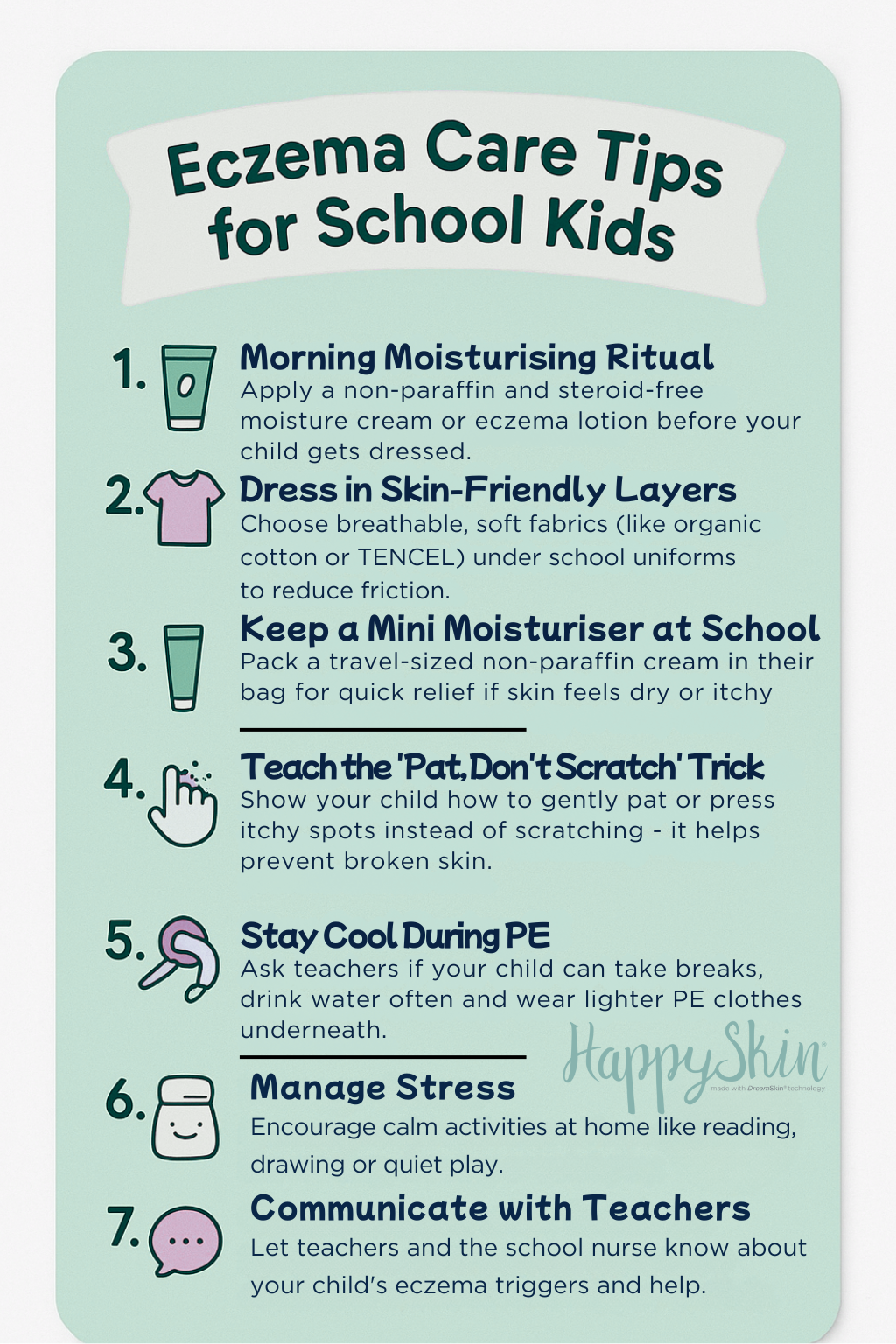
Back-to-school season can be stressful enough - new routines, new classrooms, new teachers or stocking up stationery stuffs. But for parents of children with eczema, there's another layer of worry: school uniforms. Standard trousers, gingham dresses, shirts and PE kits aren't designed with sensitive skin in mind, and the wrong fabric can trigger days of discomfort.
The good new? With the right knowledge, and a few smart swaps so you can help your child feel more comfortable and confident in their school uniform.
Why School Uniforms Can Be a Challenge for Children with Eczema
Standard uniforms are often made with polyester or wool blends, which are among the most common fabric irritant for eczema according to the NHS. These fabrics trap heat, make children sweat and can feel scratchy against inflamed skin.
Many parents notice the impact straight away:
“My son’s eczema goes BOOM if he has polyester on him – even blended into sheets or clothing. Now he has to go to school with bandages on his legs to stop the contact with the carpet.” _ a mom from UK eczema community.
Sweat, overheating, and rough seams can all worsen itching during long school days which making uniforms a key part of eczema management.
The Role of Base Layers in Protecting Skin
One of the simplest, most effective strategies is to add a soft, breathable layer beneath the uniform.
- A well-fitted eczema top under uniform provides a smooth barrier between rough uniform fabric and sensitive skin.
- Eczema base layers can also regulate temperature, preventing overheating during lessons or playtime.
The National Eczema Society recommends wearing a thin antibacterial layer under school uniforms if synthetic fabrics can’t be avoided (eczema.org). This not only reduces friction but also helps absorb sweat — two common triggers for flare-ups.
Choosing Eczema-Friendly School Uniform Pieces
When shopping for school clothes, keep these tips in mind:
- School trousers and shorts – Choose elastic waistbands without stiff seams. Avoid polyester-heavy blends when possible.
- Gingham school dresses – A summer staple, but they can irritate skin if worn directly against eczema patches. A cotton vest underneath helps.
- Shirts and polo tops – Look for hypoallergic fabric where possible, and wash before wear to remove chemical finishes.
Allergy UK emphasises that wear layers of thin clothing that your kids can take off or put on to keep them at a comfortable body temp to reduce itching (allergyuk.org).
Washing new uniforms in fragrance-free detergent, ideally twice before first wear, also helps remove irritants that may linger from the manufacturing process.
Everyday Back-to-School Tips Beyond Clothing
Comfortable uniforms are a huge step forward, but daily habits can also reduce eczema flares:
- Apply moisturiser before school to lock in hydration and protect the skin barrier.
- Talk to teachers about your child’s triggers (e.g., overheating, grass during PE, tight collars).
- For PE days, pack spare cotton layers in case sweat makes things worse.
- At home, ensure breathable eczema-friendly pyjamas help skin recover overnight.

The Back-to-School Rescue: Support for Parents
To make mornings easier, parents should try eczema-friendly vests and base layers designed to fit neatly under standard school uniforms.
These layers are:
- Breathable and cooling material
- Made with flat seams to reduce rubbing
- Designed to sit comfortably beneath trousers, dresses, and shirts
For parents, this means less stress in the mornings. For children, it means more comfort and confidence during lessons, PE, and play.
Managing eczema at school isn’t just about creams and routines — what children wear against their skin plays a huge role. With breathable layers, softer fabrics, and a bit of planning, parents don’t need to choose between school uniform rules and their child’s skin health.
The right eczema-friendly clothing makes it possible to balance both — so children can focus on learning, not itching.
Read More: What Are the 7 Different Types of Eczema in Children?

Yes — most schools allow soft base layers under uniforms, as they don’t change the appearance. These layers reduce friction and prevent overheating, making standard uniforms more comfortable
Uniforms are often made from polyester or wool blends. These fabrics can trap heat, cause sweating, and feel rough against sensitive skin — all of which can trigger flare-ups.
Wash new uniforms twice before wearing to remove chemical finishes, use fragrance-free detergents, and add a thin base layer under scratchy fabrics to reduce friction.
Yes. Scented detergents and fabric softeners can irritate sensitive skin. It’s best to use non-bio, fragrance-free detergents and avoid softeners where possible.











